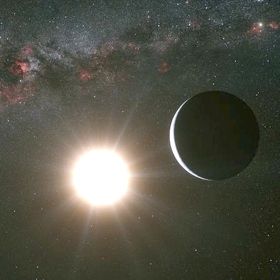New Earth-Sized Planet Discovered In Alpha Centauri, Said To Be Closest To Earth
All you pop-science and astronomy buffs — this one's for you. Alpha Centauri, the triple-star system that is the closest to us, suspended in space only about 4.4 light years from our Sun, appears to be the home of a newly discovered planet that is being said to be the closest planet to us that's outside our solar system.
The new planet, discovered by European astronomers, orbits Alpha Centauri B, the smaller of two paired stars in the system, reports the European Southern Observatory. "This result represents a major step towards the detection of a twin Earth in the immediate vicinity of the Sun. We live in exciting times!” said astronomer at the Universidade do Porto, Portugal, Xavier Dumusque and the head author of the new discovery, which has been dubbed Alpha Centauri Bb, which has nearly Earth-sized mass and is thought to be a rocky, rather than a gaseous, planet.
The new planet orbits about six million miles away from its star, much closer than Mercury is to the Sun in our solar system, making it far too hot to support life or actually be Earth-like other than in its size, orbiting pattern or makeup. But that doesn't mean that Alpha Centauri might not support other such Earth-like planets. “This is the first planet with a mass similar to Earth ever found around a star like the Sun. Its orbit is very close to its star and it must be much too hot for life as we know it,” said Stéphane Udry from the Geneva Observatory and co-author of the paper announcing the discovery. "But it may well be just one planet in a system of several," he added.
Get Uinterview's FREE iPhone App For Daily News Updates here.
Get the FREE Uinterview iPad app here and watch our videos anywhere.
For more like this:
'Diamond Planet' Discovered, Worth $26.9 Nonillion!
Alec Baldwin Hosts Discovery's 'Frozen Planet'
WATCH: First 'Prometheus' Clip Reveals Alien Planet
WATCH: Guy Pearce Quotes Nietzsche In New 'Prometheus' Video
CLOSER LOOK: Probing Ridley Scott's 'Prometheus' Trailer
1 Comments
Leave a comment
RELATED ARTICLES
Get the most-revealing celebrity conversations with the uInterview podcast!








Contrary to what science still believes, at the time of the Big Bang there were no atoms but only waves carrying energy through the infinite Void. If we could view the Universe from outside, It would look like an egg-shaped cloud with winds running in perpetual motion inside of It. The energy is like those winds running at maximum speed and pushing out the borders of the Universe.
The Universe continues to expand as the waves that travel at the border of the Universe have never encountered, nor will ever encounter, any interference from the Void. These waves will forever expand the Space of the Universe they create and leave behind.
Wave-behavior relates to the medium in which the waves travel.
Thus, wave-behavior at the border of the Universe is different than wave-behavior within the Universe.
Inside the Universe, waves change their frequencies by colliding with other energy during their travel. These waves, because of the encountered interference, continue to transform part of their original energy in other forms. Waves travel gradually releasing heat, or amounts of energy, and their original short wavelengths, in time become longer and longer as they carry less and less energy than they did when they first started to travel. These waves lose energy releasing it in form of other waves with wavelengths longer than their own.
For example, the gamma rays, over time, diminish their energy level (and their frequency) to become X rays, from X rays they will become ultraviolet and so on. The original quantum is not lost but distributed into other forms of energy through "spontaneous symmetry breaking".
Once reached an almost flat longitude (and lower critical energy level) these waves solidify into hydrogen atoms breaking up their energy in opposite elements, like the split ends of a broken hair.
When the hydrogen atoms are reached by the heat of other incoming waves they fuse together to create more complex forms of energy.
http://www.wikinfo.org/Multilingual/index.php/Wavevolution